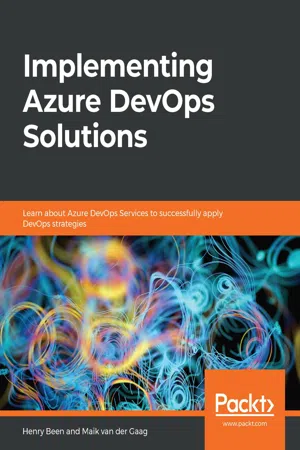
Implementing Azure DevOps Solutions
Learn about Azure DevOps Services to successfully apply DevOps strategies
- 432 pages
- English
- ePUB (mobile friendly)
- Available on iOS & Android
Implementing Azure DevOps Solutions
Learn about Azure DevOps Services to successfully apply DevOps strategies
About this book
A comprehensive guide to becoming a skilled Azure DevOps engineer
Key Features
- Explore a step-by-step approach to designing and creating a successful DevOps environment
- Understand how to implement continuous integration and continuous deployment pipelines on Azure
- Integrate and implement security, compliance, containers, and databases in your DevOps strategies
Book Description
Implementing Azure DevOps Solutions helps DevOps engineers and administrators to leverage Azure DevOps Services to master practices such as continuous integration and continuous delivery (CI/CD), containerization, and zero downtime deployments.
This book starts with the basics of continuous integration, continuous delivery, and automated deployments. You will then learn how to apply configuration management and Infrastructure as Code (IaC) along with managing databases in DevOps scenarios. Next, you will delve into fitting security and compliance with DevOps. As you advance, you will explore how to instrument applications, and gather metrics to understand application usage and user behavior. The latter part of this book will help you implement a container build strategy and manage Azure Kubernetes Services. Lastly, you will understand how to create your own Azure DevOps organization, along with covering quick tips and tricks to confidently apply effective DevOps practices.
By the end of this book, you'll have gained the knowledge you need to ensure seamless application deployments and business continuity.
What you will learn
- Get acquainted with Azure DevOps Services and DevOps practices
- Implement CI/CD processes
- Build and deploy a CI/CD pipeline with automated testing on Azure
- Integrate security and compliance in pipelines
- Understand and implement Azure Container Services
- Become well versed in closing the loop from production back to development
Who this book is for
This DevOps book is for software developers and operations specialists interested in implementing DevOps practices for the Azure cloud. Application developers and IT professionals with some experience in software development and development practices will also find this book useful. Some familiarity with Azure DevOps basics is an added advantage.
Frequently asked questions
- Essential is ideal for learners and professionals who enjoy exploring a wide range of subjects. Access the Essential Library with 800,000+ trusted titles and best-sellers across business, personal growth, and the humanities. Includes unlimited reading time and Standard Read Aloud voice.
- Complete: Perfect for advanced learners and researchers needing full, unrestricted access. Unlock 1.4M+ books across hundreds of subjects, including academic and specialized titles. The Complete Plan also includes advanced features like Premium Read Aloud and Research Assistant.
Please note we cannot support devices running on iOS 13 and Android 7 or earlier. Learn more about using the app.
Information
Section 1: Getting to Continuous Delivery
- Chapter 1, Introduction to DevOps
- Chapter 2, Everything Starts with Source Control
- Chapter 3, Moving to Continuous Integration
- Chapter 4, Continuous Deployment
Introduction to DevOps
- What DevOps is and why you cannot simply buy or install it
- How DevOps complements Agile
- What the benefits of DevOps are and how to measure them
- Creating your ideal DevOps and organizational structure
- Exploring DevOps practices and habits of successful DevOps teams
- The five stages of DevOps evolution
Technical requirements
What is DevOps?

The relation between DevOps and Agile
Agile work management
- First, switch to a flow-based way of working for developers.
- Next, allow for operations to also list their work in the same work management system as developers using synchronizations. You can also choose to implement fastlaning, an approach to expedite urgent work.
- Finally, you might choose to decommission existing ticketing tools for operations if possible.
Switching to a flow-based methodology
Synchronizing work items to one system
Table of contents
- Title Page
- Copyright and Credits
- About Packt
- Contributors
- Preface
- Section 1: Getting to Continuous Delivery
- Introduction to DevOps
- Everything Starts with Source Control
- Moving to Continuous Integration
- Continuous Deployment
- Section 2: Expanding your DevOps Pipeline
- Dependency Management
- Infrastructure and Configuration as Code
- Dealing with Databases in DevOps Scenarios
- Continuous Testing
- Security and Compliance
- Section 3: Closing the Loop
- Application Monitoring
- Gathering User Feedback
- Section 4: Advanced Topics
- Containers
- Planning Your Azure DevOps Organization
- AZ-400 Mock Exam
- Assessments
- Other Books You May Enjoy